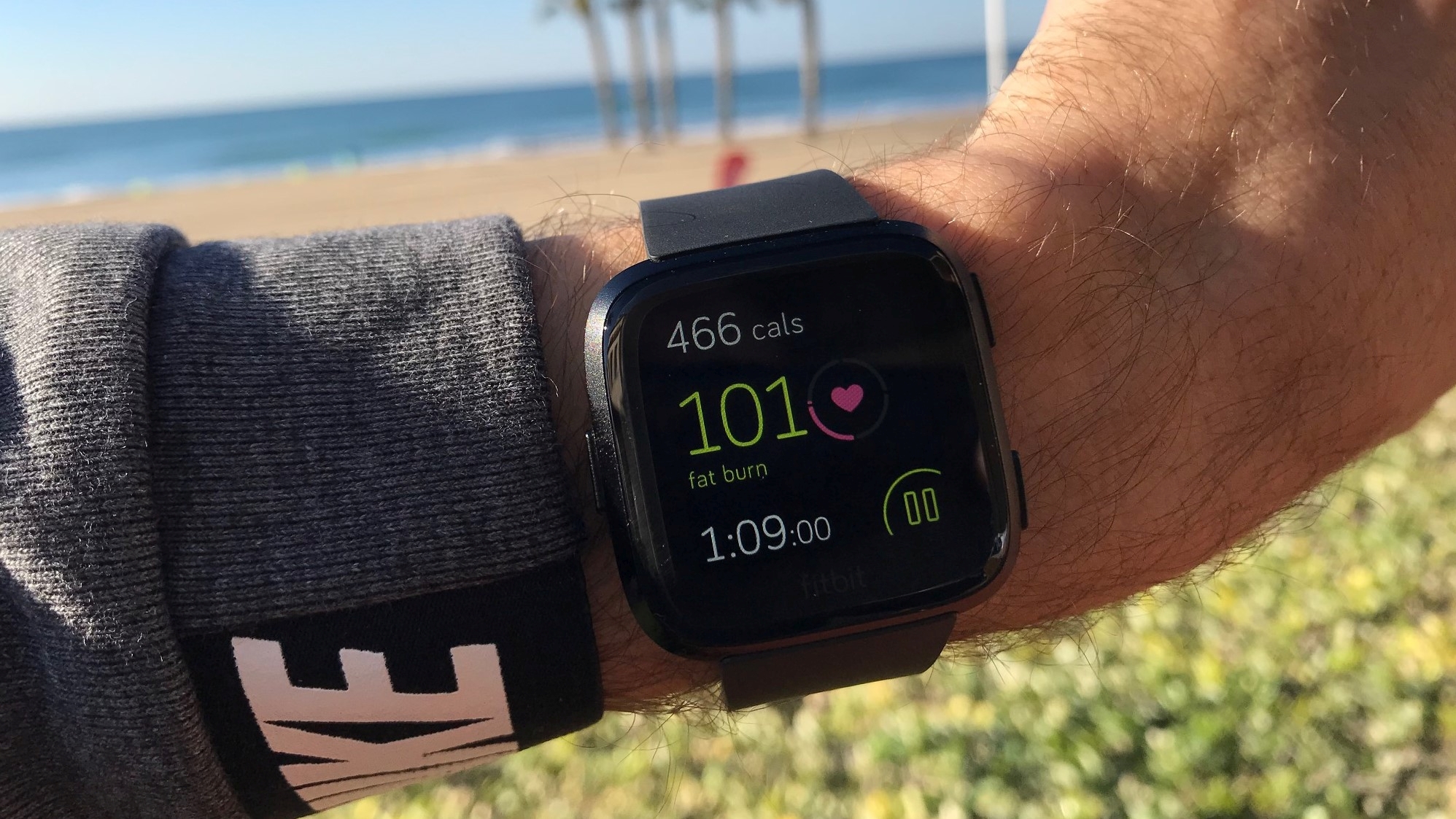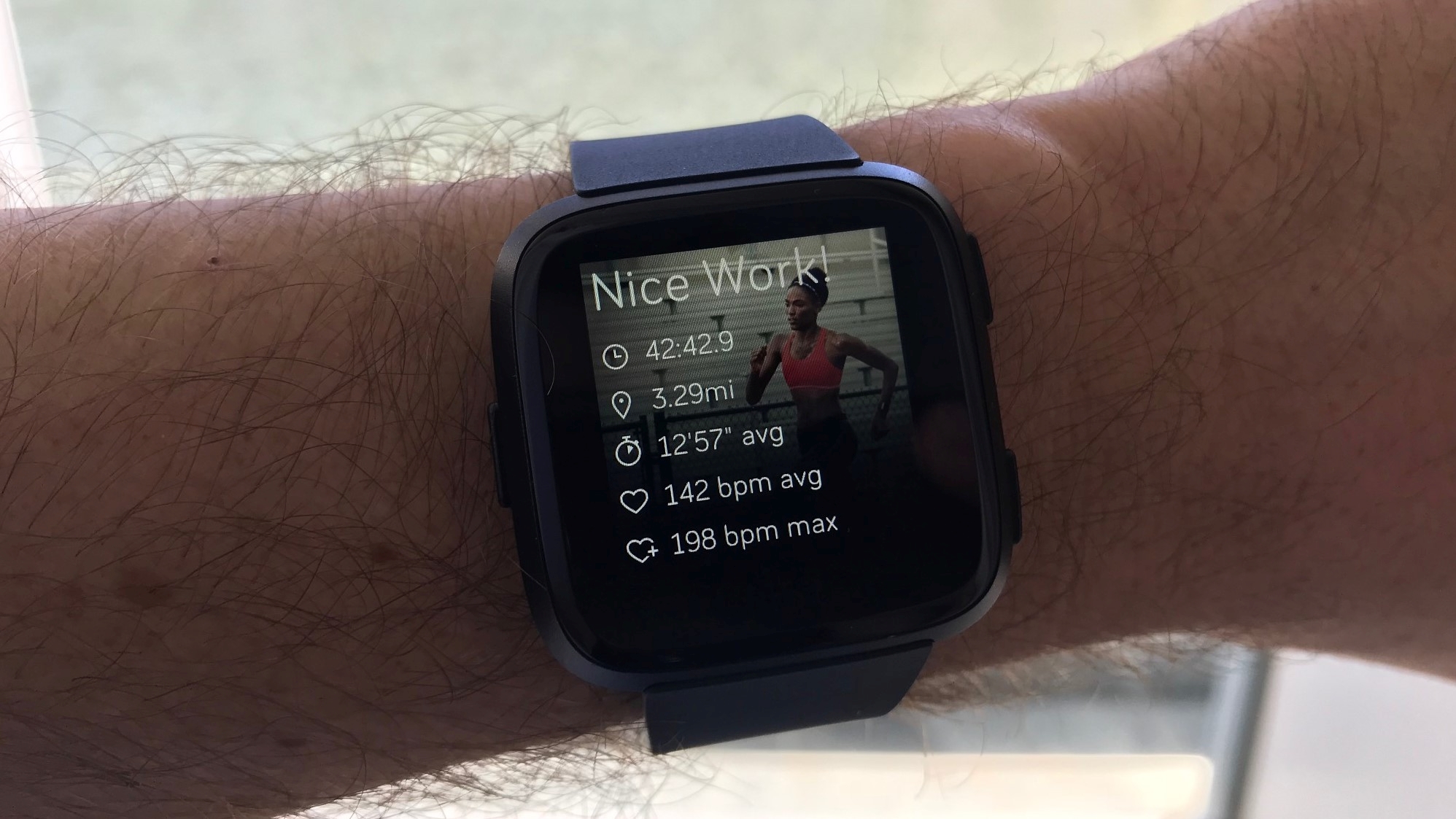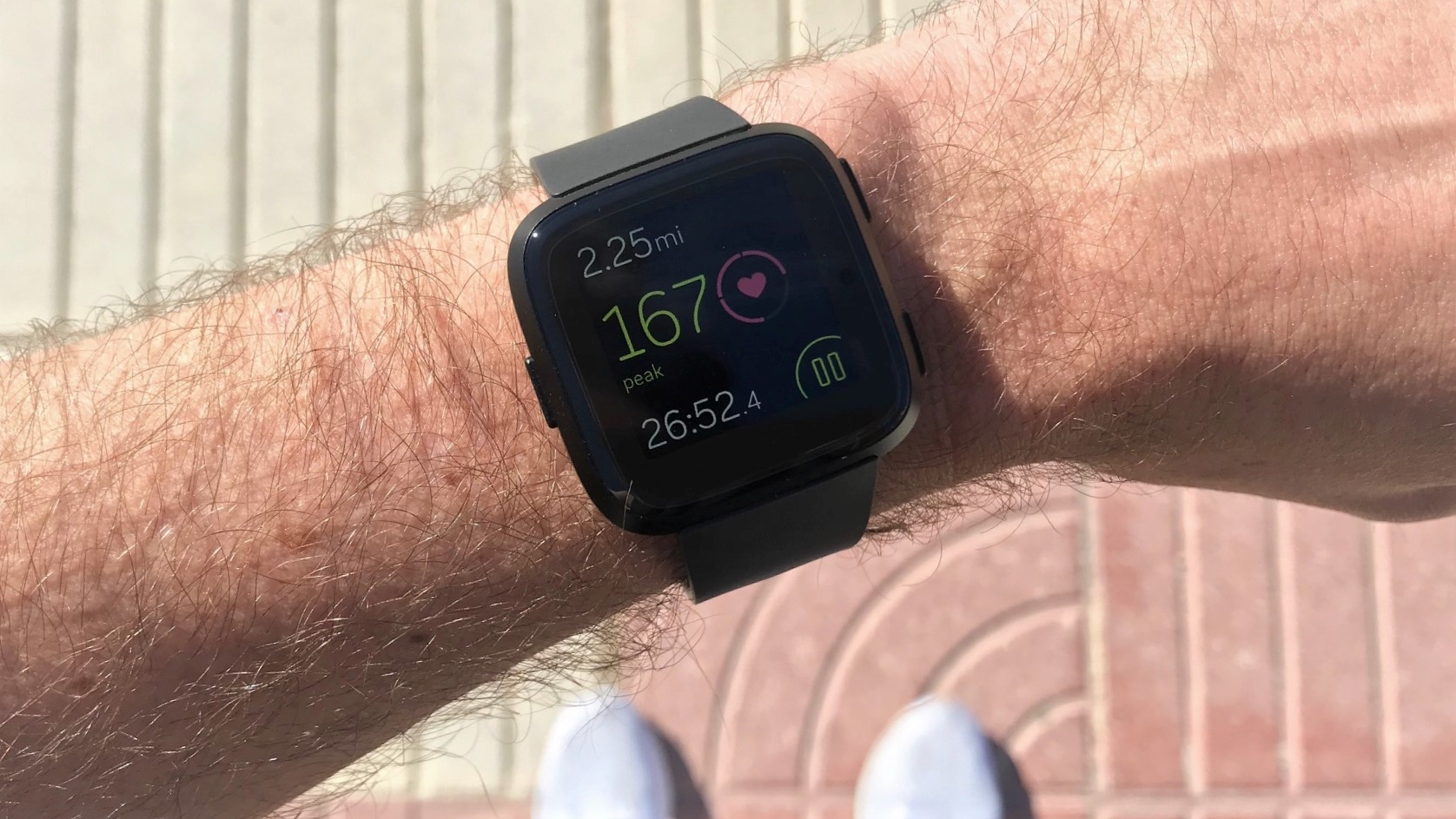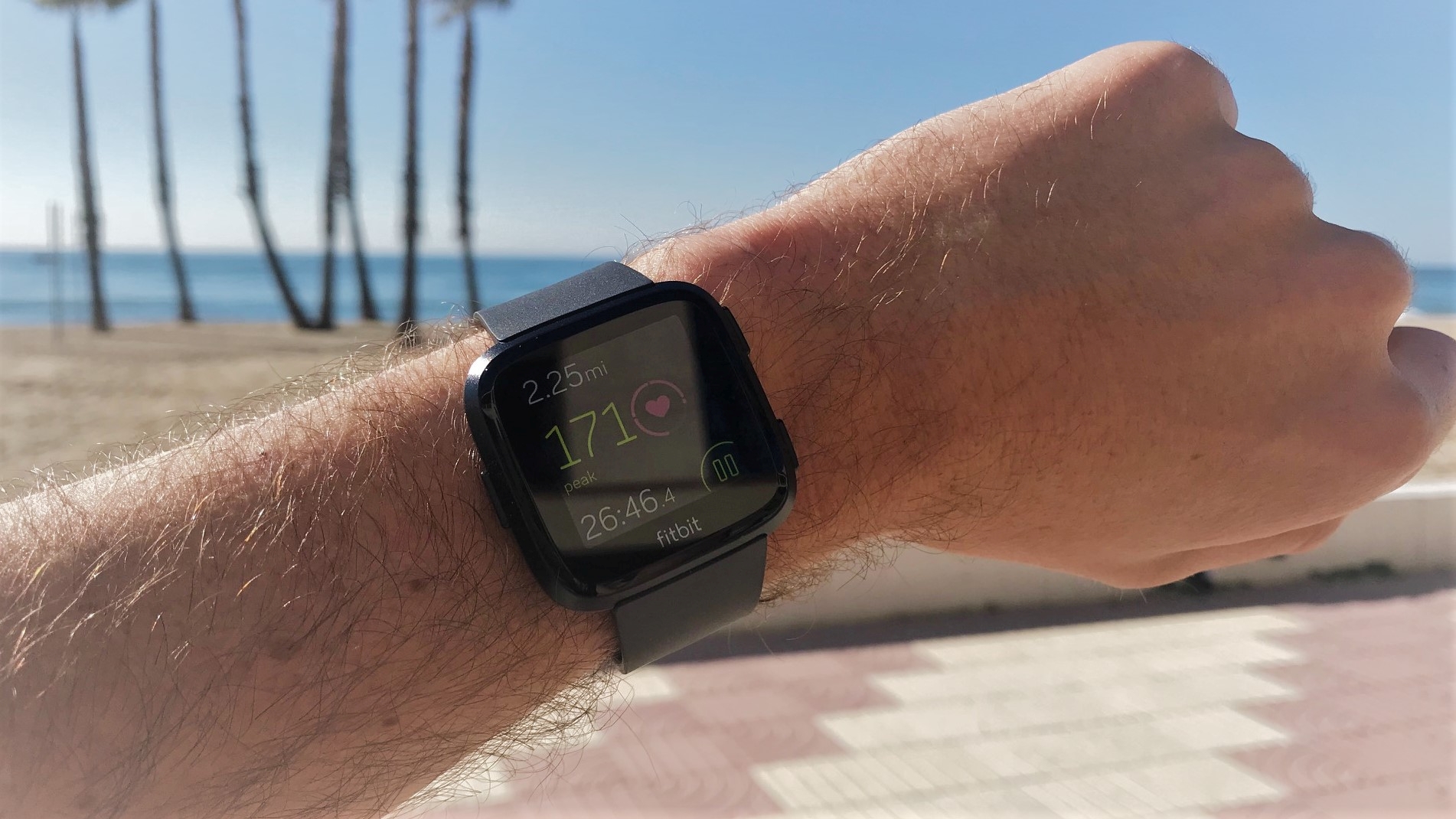Why you can trust TechRadar
Fitness features
- All major workout types covered with dedicated tracking modes
- Swim tracking works perfectly underwater
- Run detect feature accurately detects when you’ve paused for a rest
Perhaps in an attempt to stay relevant in the age of the Apple Watch 3 and now the Apple Watch 4, Fitbit has ensured the Versa is brimming with fitness features, just like it did with the Fitbit Ionic, with the only major omission being GPS.
Tracking your workout on the Versa is really straightforward and works in the exact same way as on the Ionic.
Whether it’s running, cycling, swimming or HIIT that you want to track, there’s a dedicated option for this on the watch’s Exercise app, accessible as the first option in the main menu carousel. This consists of: Run, Bike, Swim, Treadmill, Weights, Interval Timer, and Workout.
To track your run, for example, you’d simply select the Running tab from the Exercise option by swiping left from the home screen, then tap go and off you go.

During the exercise, the watch will display a selection of your vitals, which will differ depending on what exercise you’re tracking. For example, the running option will display distance and time, whereas the swimming option will display the lengths and meters swam alongside the time, and then the general workout option will show heart rate the calories burned.
Many other tracking variables can also be seen, such as the current time and time taken, by swiping left or right on the main display during the exercise tracking.

Once you’ve ended your exercise by telling the Versa you’re done, you’ll get a workout summary. These little summaries are a great touch, giving you the lowdown on your performance as soon as you’ve finished.
In our running session for instance, the Versa workout summary told us what our maximum heart rate had been in beats per minute (BPM), alongside our average BPM during the whole exercise, the time it took to complete the workout and the distance traveled.
As with the display during exercise, this summary changes depending on the exercise you do. After a HIIT class, in which we’d chosen the standard 'workout' option, we were told how many calories we’d burned as opposed to distance traveled and time taken.
This is all viewable in the app, too, after you’ve synced your watch to your smartphone, alongside all the other variables, side by side with any previous workouts you’ve done.
Another impressive tracking capability for a wearable at this price point is the swim tracking. We say impressive because in order to do this, Fitbit obviously had to make the Versa completely waterproof (to 50 meters), which not only means you can get it wet, but you can use it to track your water activities with a dedicated swimming mode.
It works swimmingly (sorry) as well. It accurately tracks your laps in a pool for instance, recognizing in real-time when you’ve reached the other side and kicked off to start your next lap.
What really took us by surprise was that the Versa was able to offer clear and concise on-screen information with its brightly-lit display under the water. It isn’t easy to swipe between the different tracking variables during this mode though, as you can imagine, as the display doesn’t recognize finger taps so well underwater.
Some might be disappointed by that, but actually it was handy for us and stopped us swiping away from the important tracking screen.

Thanks to the device’s Run Detect feature, which was also seen on the Ionic, the Versa is clever enough to know when you’re taking a break, and automatically stops and starts tracking a run, swim or cycle by sensing the status of your movement.
The other good news here is that this feature doesn’t come into play if you don’t want it. Choose a standard 'workout' exercise from the list before beginning circuit training, for example, and it tracks your heart rate continuously, until you tell it to stop.
It works really well, meaning you can get on with the workout without checking the watch all the time and making sure it’s recording your movements accurately.
Last but not least is sleep. While this tracking function isn’t exactly a fitness feature, it still works in a similar way. However, it’s not something you activate in the menu. If you wear the Versa to bed, it will automatically track your sleep by recognizing your inactivity, stillness and decreased heart rate.
A summary of your sleep pattern will then be offered within the app after waking up, displaying how long you were asleep for in total, with this time split into REM (rapid eye movement), light and deep sleep.
This analysis is provided in an easy to understand and insightful way, pitting your results against an ideal target 'benchmark' of someone the same sex and age as you.
Fitbit still remains one of our top wearable options to sleep tracking thanks to its comprehensive data and easy-to-understand 'Sleep Stages' graphs.
Performance and battery life
- Performance is generally nippy
- Battery lasts for around 3-4 days on a single charge
- Versa charger is proprietary and comes with a clip-in dock
Fitbit claims the Versa’s battery life is not quite as impressive as its bigger, more expensive sibling the Ionic, cited at four days instead of the Ionic’s five. After using the watch for a good two weeks on and off, we were rather impressed that its stamina matched up pretty well with Fitbit’s claims.

Obviously the total number of days you’ll get out of the Fitbit Versa is completely dependent on how many workouts you track throughout the week, if you keep it on at night for sleep tracking, and if you have the brightness setting set to low or high.
After a full charge and using it for a full 24 hours, including two intense workouts and sleep, it was at a rather impressive 70% capacity. After three full days, it was just over 10% before finally dwindling to zero halfway through the fourth day.
As for actual device charging, Fitbit doesn't opt for juicing its wearables via traditional micro USB - so if you are travelling then the special Fitbit charger will need to make its way into your suitcase.
It’s also worth noting the Versa’s proprietary charger comes with a clip-in dock (included), which makes it much easier to charge compared to the magnetic pin on the Ionic.
Image Credit: TechRadar
Current page: Fitness features and battery life
Prev Page Introduction, price and design Next Page Interface and appLee Bell is a freelance journalist & writer specializing in consumer technology, health, and lifestyle. Lee is a qualified personal trainer, testing fitness watches, training shoes and everything in between.

